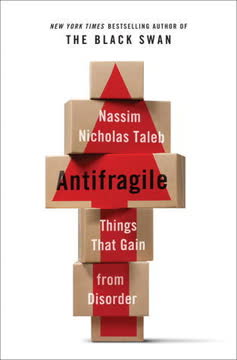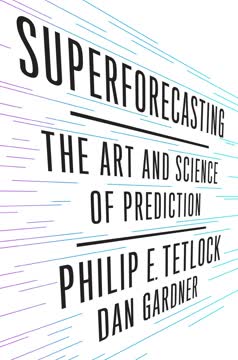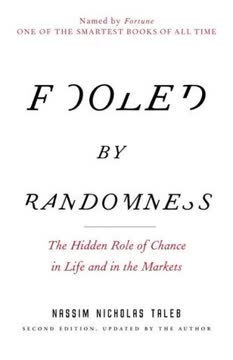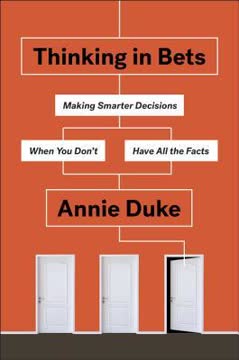Key Takeaways
1. Life is more like poker than chess: embrace uncertainty
Unlike in chess, we can't simply work backward from the quality of the outcome to determine the quality of our beliefs or decisions.
Uncertainty is inevitable. In life, as in poker, we make decisions with incomplete information and unpredictable outcomes. Unlike chess, where all pieces are visible and moves are deterministic, real-world scenarios involve hidden information and chance events.
Embrace probabilistic thinking. Instead of seeking certainty, focus on making the best decisions possible given the available information. Recognize that even good decisions can lead to unfavorable outcomes due to factors beyond our control.
Adapt to changing circumstances. Be prepared to adjust your strategy as new information becomes available. Flexibility and adaptability are crucial in navigating the uncertainties of life and decision-making.
2. Our beliefs shape our decisions, but they're often flawed
We form beliefs in a haphazard way, believing all sorts of things based just on what we hear out in the world but haven't researched for ourselves.
Beliefs are often unchallenged. Most of our beliefs are formed passively, based on information we encounter without critically examining its validity. This can lead to misconceptions and biased decision-making.
Recognize cognitive biases. Our brains are wired to take shortcuts, which can result in flawed reasoning:
- Confirmation bias: Seeking information that confirms existing beliefs
- Availability bias: Overestimating the likelihood of events we can easily recall
- Anchoring bias: Relying too heavily on the first piece of information encountered
Actively challenge your beliefs. Regularly question your assumptions and seek out diverse perspectives. Be open to changing your mind when presented with new evidence or compelling arguments.
3. Resulting: the dangerous habit of judging decisions by outcomes
Outcomes don't tell us what's our fault and what isn't, what we should take credit for and what we shouldn't.
Avoid outcome bias. Resist the temptation to judge the quality of a decision solely based on its result. Good decisions can lead to bad outcomes due to chance, and poor decisions can sometimes yield positive results.
Focus on the decision-making process. Evaluate decisions based on the information available at the time and the reasoning behind the choice. Consider:
- Was the decision well-informed?
- Were alternative options considered?
- Was the risk appropriately assessed?
Learn from both successes and failures. Analyze the factors that contributed to outcomes, distinguishing between elements within your control and those that were unpredictable or external.
4. Redefine "wrong" to improve decision-making
Redefining wrong allows us to let go of all the anguish that comes from getting a bad result.
Embrace uncertainty in outcomes. Recognize that few decisions have guaranteed results. Instead of labeling decisions as "right" or "wrong," consider them in terms of probability and potential outcomes.
Shift focus to decision quality. Evaluate choices based on the thought process and available information, rather than solely on results. Ask yourself:
- Did I consider all relevant factors?
- Was my reasoning sound?
- Did I account for potential risks and uncertainties?
Cultivate a growth mindset. View "mistakes" as learning opportunities rather than failures. This approach promotes continuous improvement and reduces decision paralysis caused by fear of being wrong.
5. Treat decisions as bets to make better choices
Thinking in bets starts with recognizing that there are exactly two things that determine how our lives turn out: the quality of our decisions and luck.
Frame decisions as bets. Approach choices as if you're wagering on potential outcomes. This mindset encourages more careful consideration of risks and probabilities.
Consider the stakes. Evaluate the potential consequences of each decision:
- What's the best possible outcome?
- What's the worst-case scenario?
- How likely are various outcomes?
Improve your odds. Focus on factors within your control to increase the likelihood of favorable outcomes:
- Gather more information
- Seek expert advice
- Consider alternative perspectives
6. Combat bias by learning from experience objectively
Experience can be an effective teacher. But, clearly, only some students listen to their teachers.
Actively seek feedback. Regularly review the outcomes of your decisions to identify patterns and areas for improvement. Be open to both positive and negative feedback.
Avoid self-serving bias. Resist the temptation to attribute successes solely to skill and failures entirely to luck. Strive for an objective assessment of your decisions and their outcomes.
Create a decision journal. Document important decisions, including:
- The context and available information
- Your reasoning and expectations
- The actual outcome and any unexpected factors
Periodically review this journal to identify trends and improve your decision-making process.
7. Form a decision-making pod for better outcomes
Just as we can recruit other people to be our decision buddies, we can recruit other versions of ourselves to act as our own decision buddies.
Assemble a diverse group. Create a "decision pod" of trusted individuals with varied perspectives and expertise. This diversity helps combat individual biases and blind spots.
Establish ground rules. Set clear guidelines for group interactions:
- Encourage respectful disagreement
- Focus on the quality of reasoning, not just outcomes
- Maintain confidentiality when appropriate
Leverage collective wisdom. Use your decision pod to:
- Brainstorm alternative options
- Identify potential risks and opportunities
- Challenge assumptions and biases
8. Communicate effectively within and outside your group
Expressing our beliefs this way also serves our listeners. We know that our default is to believe what we hear, without vetting the information too carefully.
Practice transparency. Be open about your level of certainty and the reasoning behind your beliefs. Use phrases like "I'm X% confident that..." to convey uncertainty.
Encourage constructive dissent. Create an environment where disagreement is viewed as valuable input rather than criticism. Ask questions like:
- "What perspectives might we be missing?"
- "Can anyone play devil's advocate?"
Tailor communication to your audience. When sharing ideas outside your decision pod:
- Lead with areas of agreement
- Use "and" instead of "but" to build on ideas
- Frame suggestions in terms of future improvements rather than past mistakes
9. Use mental time travel to make smarter decisions
Backcasting and premortems complement each other. Backcasting imagines a positive future; a premortem imagines a negative future.
Envision future scenarios. Use mental time travel techniques to anticipate potential outcomes and prepare for various possibilities:
- Backcasting: Imagine a successful future and work backward to identify necessary steps
- Premortems: Envision potential failures and plan preventive measures
Consider long-term consequences. Use the "10-10-10" rule to evaluate decisions:
- How will you feel about this decision in 10 minutes?
- In 10 months?
- In 10 years?
Recruit your future self. Imagine how your future self would advise your present self. This perspective can help align short-term actions with long-term goals.
10. Implement backcasting and premortems in decision-making
By keeping an accurate representation of what could have happened (and not a version edited by hindsight), memorializing the scenario plans and decision trees we create through good planning process, we can be better calibrators going forward.
Backcast for success. Start with a desired future outcome and work backward:
- Clearly define the goal
- Identify key milestones and necessary actions
- Consider potential obstacles and how to overcome them
Conduct premortems. Imagine a future where your decision has failed:
- Envision worst-case scenarios
- Identify potential causes of failure
- Develop preventive measures and contingency plans
Document your process. Keep a record of your scenario planning and decision trees. This helps:
- Avoid hindsight bias when reviewing past decisions
- Improve future decision-making by learning from previous experiences
- Maintain perspective on the range of possible outcomes, not just what actually happened
Last updated:
FAQ
What's Thinking in Bets about?
- Decision-Making Focus: Thinking in Bets by Annie Duke explores decision-making in uncertain environments, using betting as a framework to analyze choices. It compares life to poker, where outcomes are influenced by both skill and luck.
- Learning from Outcomes: The book emphasizes understanding the difference between luck and skill to improve decision-making. By treating decisions as bets, individuals can better evaluate their choices and learn from results.
- Practical Strategies: Duke provides strategies for separating decision quality from outcome quality, encouraging readers to embrace uncertainty and think probabilistically.
Why should I read Thinking in Bets?
- Enhanced Decision-Making: The book helps improve decision-making skills by teaching readers to recognize and mitigate biases, leading to more rational choices in personal and professional contexts.
- Real-World Applications: Concepts are applicable across various fields, including business and finance, helping readers navigate uncertainty more effectively.
- Engaging Narrative: Duke's experiences as a professional poker player make the book informative and entertaining, illustrating complex concepts in an accessible way.
What are the key takeaways of Thinking in Bets?
- Life as Bets: Every decision is a bet on an uncertain future, encouraging evaluation of risks and rewards associated with choices.
- Avoiding Resulting: Duke stresses not equating decision quality with outcomes, understanding that luck plays a role, which helps in learning from experiences.
- Embracing Uncertainty: The book advocates for accepting uncertainty and encourages saying, “I’m not sure,” leading to better decision-making and belief assessment.
What are the best quotes from Thinking in Bets and what do they mean?
- “Thinking in bets will improve decision-making throughout our lives.”: This quote encapsulates the book's premise that a betting mindset enhances informed choices.
- “We can get better at separating outcome quality from decision quality.”: Highlights the importance of distinguishing between decision results and the decisions themselves for objective learning.
- “I’m not sure” is a vital step to being a better decision-maker.: Emphasizes acknowledging uncertainty, leading to more thoughtful and less reactive decision-making.
How does Annie Duke define a "bet" in Thinking in Bets?
- Broad Definition: A bet is “a choice made by thinking about what will probably happen,” applicable to everyday decisions involving risk assessment.
- Risk and Belief: Involves risking something valuable based on beliefs about future events, encouraging evaluation of outcome likelihoods.
- Decision-Making Framework: Framing decisions as bets allows for better analysis of choices and influencing factors, leading to improved outcomes.
What is the "Buddy System" in Thinking in Bets?
- Collaborative Learning: Involves forming a group committed to truth-seeking and improving decision-making together, holding each other accountable.
- Accountability and Support: Group members provide feedback and challenge beliefs, fostering open-mindedness and reducing biases.
- Diversity of Opinions: A diverse group combats confirmation bias and promotes exploratory thought, essential for accurate and informed decisions.
What is "resulting," and why is it a problem in decision-making?
- Definition of Resulting: Resulting is evaluating decision quality based solely on its outcome, a cognitive bias leading to misjudgments.
- Impact on Learning: Equating outcomes with decision quality can hinder learning from mistakes or overestimating skills, affecting future decisions.
- Example in Sports: Duke uses Pete Carroll’s Super Bowl play call to illustrate resulting, where critics judged the decision based on the negative outcome.
How can I separate luck from skill in my decision-making according to Thinking in Bets?
- Fielding Outcomes: Actively analyze decision outcomes to determine influence by skill or luck, asking critical questions about contributing factors.
- Learning Loop: Create a feedback loop to assess decisions and outcomes, identifying growth areas and refining beliefs.
- Embrace Uncertainty: Accepting luck's role in outcomes allows focus on controllable decision-making processes, fostering resilience and adaptability.
What strategies does Thinking in Bets suggest for improving decision-making?
- Think Probabilistically: Adopt a mindset assessing outcome likelihoods before decisions, clarifying risks and rewards.
- Practice Self-Reflection: Reflect on past decisions and outcomes to identify thinking patterns and biases, improving future choices.
- Engage in Truth-Seeking: Seek diverse perspectives and challenge beliefs for a more accurate world understanding, combating biases.
How does Thinking in Bets address the role of emotions in decision-making?
- Emotional Influence: Emotions significantly impact decision-making, often leading to irrational choices; recognizing this is essential for objectivity.
- Strategies for Managing Emotions: Techniques like stepping back to assess situations rationally help maintain focus on decision-making processes.
- Building Resilience: Understanding and managing emotions builds resilience, allowing better navigation of uncertainty and improved outcomes.
How does Thinking in Bets relate to personal finance and investing?
- Probabilistic Thinking: Encourages applying probabilistic thinking to financial decisions, assessing risks and potential returns for informed choices.
- Long-Term Perspective: Emphasizes maintaining a long-term perspective in investing, focusing on trends and probabilities over short-term fluctuations.
- Learning from Outcomes: Advocates analyzing past investment decisions to refine strategies and improve decision-making.
What role does mental time travel play in Thinking in Bets?
- Future Self-Awareness: Involves envisioning future outcomes and considering current decisions' impact on future selves, enhancing decision quality.
- Regret Anticipation: Anticipating potential regret helps avoid impulsive actions by considering future feelings about decisions.
- Scenario Planning: Encourages imagining possible futures based on current decisions, identifying risks and opportunities for strategic choices.
Review Summary
Thinking in Bets receives mixed reviews. Many praise its insights on decision-making, emphasizing the role of uncertainty and luck. Readers appreciate Duke's poker-based perspective and practical advice for overcoming cognitive biases. Some find the book repetitive or lacking depth, while others consider it a valuable framework for better decision-making. Critics argue that the content is not entirely original and could have been more concise. Overall, reviewers recommend it for those interested in improving their decision-making skills, especially if unfamiliar with behavioral economics concepts.
Similar Books










Download PDF
Download EPUB
.epub digital book format is ideal for reading ebooks on phones, tablets, and e-readers.






